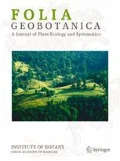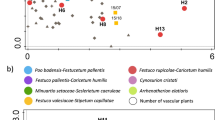Abstract
In a semi-natural, species-rich perennial grassland community permanent plots during secondary succession induced by herbicides selective to dicots and monocots and herbicides of total effect. The effectiveness of using different similarity matrices in detecting vegetation dynamic changes was investigated.
Differences caused by treaments in (1), the coenological similarity relations, (2) the direction of secondary succession, (3) the rates of change measured as floristic change (Sörensen index) and as change of species cover (Czekanowski’s coefficient), (4) the reestablishment of the original state, (5) the seasonal dynamics, (6) the responses to stress situation (drought) have been analysed.
The vegetation dynamic processes of the community near stable state were mainly influenced by the differences between years. During the 5 years of study the changes referred to the first sampling date showed a trend induced by changing climatic conditions. In the intact community, seasonal fluctuations can be detected very well. The community rich in species has been proved to be resistant to drought, but resilience referring to its recovery following disturbance was relatively small.
After having been drastically disturbed from its dynamically stable state, the grassland community regenerated very slowly. In fact, the community could not recover its original state within five years.
The direction and rate of change of the secondary successional and regeneration processes have been determined primarily by the species first occupying the bare ground after herbicide treatment, and the vegetative regeneration of the species present, namely the “competition for space”. The main differences between treatments lie in the behaviour of the constituent species in the different coenostates developed following the disturbance.
Similar content being viewed by others
Literature Cited
Abul-Fatih H. A. etBazzaz F. A. (1979): The biology ofAmbrosia trifida. I. Influence of species rrmoval on the organization of the plant community.—New Phytol., 83: 813–816.
Allen E. R. etForman R. T. T. (1976): Plant species removals and old-field community structure and stability.—Ecology, 57: 1233–1243.
Armesto J. J. etPickett S. T. A. (1986): Removal experments to test mechanisms of plant succession in oldfields.—Vegetatio, 66: 85–93.
Bornkamm R. (1981): Rates of change in vegetation during secondary succession.— Vegetatio, 47: 213–220.
Czekanowski J. (1909): Differenti aldiagnose der Neantertalgruppe.—Koriespbl. dt. Ges. Anthrop., 40: 44–47.
Clements F. E. (1916): Plant succession.—Carnegie Inst. Wash. Publ., 242: 512 pp.
Collins S. L. etAdams D. E. (1983): Succession in grasslands: 32 years of change in a central Oklahoma tallgrass prairie.—Vegetatio, 51: 181–190.
Connell J. H. etSlatyer R. O. (1977): Mechanisms of succession in natural communities and their role in community stability and organization.—Amer. Nat., 111: 1119–1144.
Dayton P. K. (1975): Experimental evaluation of ecological dominance in a rocky intertidal algae community.—Ecological Monograps, 45: 137.
Fekete G. etVirágh K. (1982): Vegetációdinamikai kutatások és a gyepek degradációja. [Study of vegetation dynamics and degradation of grasslands.]—MTA. Biol. Oszt. Közl., 25: 415–420.
Fowler N. (1981): Competition and coexistence in a North Carolina grassland. II. The effects of the experimental removal of species.—J. Ecology, 69: 843–954.
Glenn-Levin D. C. (1980): The individualistic nature of plant community development.— Vegetatio, 43: 141–146.
Grime J. P. (1979): Plant strategies and vegetation processes.—John Wiley and Sons, Chishester.
Harrison G. W. (1976): Stability under environmental stress: resistance, resilience, persistence and variability.—Amer. Nat., 113: 659–669.
Hils M. H. etVankat J. L. (1982): Species removals from a first-year old-field plant community.—Ecology, 63: 705–711.
Holling C. S. (1973): Resilience and stability of ecological systems.—Ann. Rev. Ecol. Syst., 4: 1–23.
Kindlmann P. etLepš J. (1985): What is stability? A mathematician’s and ecologist’s point of view.—In:Sydow A., Thoma M. etVichnevetsky R. [eds.]: System Analysis and Simulation 1985, II. Applications.—Proceedings of the Internat. Symp. held in Berlin (GDR), Aug. 26–31.—Akademie Verlag, Berlin. 201–204.
Lepš J., Osbornová-Kosinová J. etRejmánek M. (1982): Community stability, complexity and species life history strategies.—Vegetatio, 50: 53–63.
Mahn E. G. etHelmecke K. (1979): Effects of herbicide treatment on the structure and functioning of agro-ecosystems. II. Structural changes in the plant community after the application of herbicides over several years.—Agro-Ecosystems, 5: 159–179.
Máthé I. etKovács M. (1972): Die Vegetation des Sárhegy bei Gyöngyös.—Bot. Közlem. 49: 309–328.
Pinder J. E. (1975): Effects of species removal on an old-field plant community.—Ecology, 56: 747–751.
Putwain P. D. etHarper J. L. (1970): Studies in the dynamics of plant populations. III. The influence of associated species on populations ofRumex acetosa L. andR. acetosella L. in grassland.—J. Ecol., 58: 251–264.
Rejmánek M. (1979): Stability and complexity in biotic communities: Theoretical and empirical approach. In:M. Ružička [ed.]: 5th Internat. Symp. Probl.—Ecol. Land. Res., Bratislava, 65–72.
Rykiel E. J. Jr. (1985): Towards a definition of ecological disturbance.—Aust. J. Ecol. 10: 361–365.
Sagar G. R. etHarper J. L. (1961): Controlled interference with natural populations ofPlantago lanceolata, P. major andP. media.—Weed Res., 1: 163–176.
Soó R. (1980): Taxonomical and phytogeographical handbook of the Hungarian flora VI. Akad. Kiadó, Budapest, 557 pp.
Sørensen (1984): A method for establishing groups of equal amplitude in plant sociology based on similarity of species content and its application to analyses of the vegetation on Danish commons.—Biol. Skr. 5/4: 1–34.
Sousa W. P. (1980): The responses of a plant community to disturbance: the importance of successional age and species life histories.—Oecologia, 45: 72–81.
Turner T. (1983): Complexity of early and middle successional stages in a rocky intertidal surfgrass community.—Oecologia, 60: 56–65.
Virágh K. (1982): Vegetation dynamics induced by some herbicides in a perennial grassland community, I.—Acta Bot. Acad. Sci. Hung., 28: 427–447.
Virágh K. etFekete G. (1984): Degradation stages in a xeroseries: composition, similarity, grouping, coordination.—Acta Bot. Acad. Sci. Hung., 30: 427–459.
Westman W. E. etO’Leary J. F. (1986): Measures of resilience: the response of coastal sage scrub to fire.—Vegetato, 65: 179–189.
Yodzis P. (1978): Competition for space and the structure of ecological communities.— Lecture Notes in Biomathematics, 25. Springer, Berlin, Heidelberg-New York. 191 pp.
Author information
Authors and Affiliations
Rights and permissions
About this article
Cite this article
Virágh, K. The effect of herbicides on vegetation dynamics: A five year study of temporal variation of species composition in permanent grassland plots. Folia geobot. phytotax. 22, 385–403 (1987). https://doi.org/10.1007/BF02853236
Received:
Issue Date:
DOI: https://doi.org/10.1007/BF02853236




